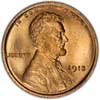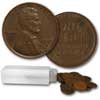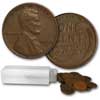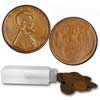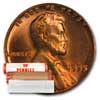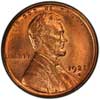1922-D cents displaying full strikes are available, though the majority of this date reveal varying degrees of weakness. The example illustrated was coined with a fresh obverse die that was paired with an already worn reverse that may have left over from the 1920-D production.
Erosion of the obverse die, perhaps in combination with the mintmark cavity catching grease or other debris, led to the coining of numerous 1922-dated cents at Denver that revealed no mintmark. Three die marriages are known displaying this phenomenon, but the most highly desired is the one in which the reverse die is fresh and sharp.
David W. Lange writes in The Complete Guide to Lincoln Cents: "The significance and great value attached to the 1922 cent without mintmark D is based entirely on the curious coincidence of no cents being coined at the Philadelphia Mint during 1922. There's no telling how many other times that cents were issued from the branch mints without a visible mintmark; such pieces are automatically branded as P-Mint coins, though the generally poor state of the dies would be a clue to their real status."
This popular oddity is not a true variety, as the obverse die began its term normally and then deteriorated to the point that its mintmark vanished. It is actually a die state, and as such should command little attention, but early publicizing of these defective coins by Maurice Scharlack and other dealers cemented its place in United States coin collecting.
Though not quite as popular as the die marriage having a sharp reverse from a fresh die, this version of the No D cent is likewise collectable. Its reverse die is severely worn, with the wheat heads being quite blurry and the fields beginning to buckle, even on Mint State pieces. Its obverse is easily distinguished from the Strong Reverse variety by its second 2 being weaker than the first.
Mintage:
| Denver |
| 7,160,000 |



